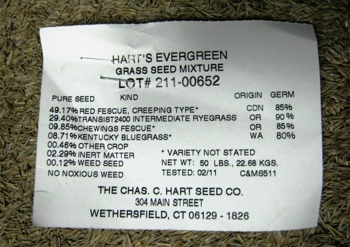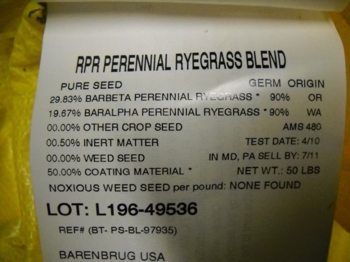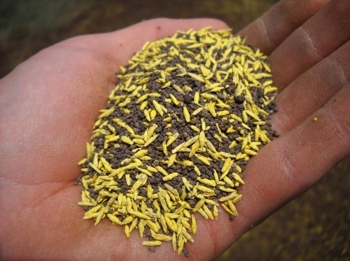Being able to understand the information on a grass seed label will help in selecting a high-quality seed. All mixes and blends of grass seed are not of the same quality, but all seed labels must list certain information which will enable the buyer to decide whether that particular seed is of a quality suitable for their needs. It may not be necessary or practical to use a high-quality seed in all situations, but the information on the label will still be useful.
The following label properties and their references are listed in the same order as they would appear on the bag of seed:
Purity- This is the % by weight per bag of the particular species of grass seed. In the sample label, the purity of the creeping red fescue is 49.17%. If the whole bag weighed 100 lbs., then 49.17 lbs. would be creeping red fescue.
Variety- This is the specific cultivar of the species. In the same sample label shown below, the ryegrass variety is Transition 2400, which has genetic characteristics singular to that variety of ryegrass. Certain cultivars may be desirable because they are disease or insect resistant or are better adapted to shade or other environmental conditions than other cultivars of the same species.
Germination- This is the % of the pure seed that should be expected to germinate when properly planted. The higher the % the better. Most grass seeds should have a germination of 85% or better. No seed can be guaranteed to germinate at a 100% rate.
Other Crop- This is the % by weight of other seeds in the bag that are grown as a cash crop, and may include clover, timothy, and bentgrass, which are considered weeds in turf.
Weed Seed- This is the % by weight of any weed seeds in the package that have not been included in pure seed or crop. The desirable amount of weed seeds should be less than 1%, the ideal being 0%.
Noxious Weeds- This is the % of weed seeds that are considered undesirable, and in some states are they considered legally undesirable. The best quality seed will say ‘None Found’ or ‘No Noxious Weed’ as seen on our sample label. Noxious weeds are considered extremely difficult to eradicate, once present, or of a serious detriment to the desirable grass.
Inert Matter- This is the % of material that will not grow, and could be chaff from the seed harvesting process, or other matter that cannot produce plants.
Date Tested- The last date that the germination test was completed. Check to make sure the seed has been tested sometime in the current year. After a few years, some seed is not viable, or the % of germination is considerably less.
Seed Lot- This provides a way to trace the history, or origin, of that particular seed. It is useful when problems are detected and provides a means to track the seed.
Percentage of Live Seed
There is another useful fact to know about grass seed, and that is called the percentage of live seed. This is the % of seed in the bag that is guaranteed to germinate. It is determined by multiplying the purity by the % of germination of the individual varieties of seed. If 90% of a bag is Merion Kentucky Bluegrass, and the germination % is 90%, then the % of live seed is 81.
If the weight of the bag is 100 lbs., for example, and 81% of the Merion Kentucky Bluegrass is guaranteed to germinate, then 81 pounds of the seed will actually germinate; 19 pounds will not. If the area being seeded needs a rate of 100 pounds of seed to provide an adequate stand of turf, then you will need to get more seed.
Bear in mind that grass seed that is coated with any or all of the above substances will have the percentage of the coating weight included on the seed label. This must be factored in by the buyer, as coatings may make up half of the weight of the contents of the bag.
When determining how much seed you will need, buy a little extra in case the new turf is still thin in spots. Purchase seed from reputable seed companies that list the cultivars of individual varieties. Both shade and sun mixes are available which should have the latest and best cultivars. There are also endophyte-enhanced turf grasses that help the grass resist surface-feeding insects, diseases, and other stresses. There are also specific cultivars that have shown resistance to certain diseases. Do some research when deciding what grasses will be best for your specific soil and environmental conditions.
All photos © Pamm Cooper
UConn Home and Garden Education Center, 2019
Issued in furtherance of Cooperative Extension work, Acts of May 8 and June 30, 1914, in cooperation with the U.S. Department of Agriculture, the Dean of the College, Cooperative Extension System, University of Connecticut, Storrs. The Connecticut Cooperative Extension System is an equal opportunity employer and program provider. To file a complaint of discrimination, write USDA, Director, Office of Civil Rights, Room 326-W, Whitten Building, Stop Code 9410, 1400 Independence Avenue, SW, Washington, DC 20250-9410 or call (202) 720-5964.




